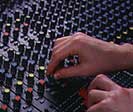| Author
|
I don't know !!!
|
Freeflow
IsraTrance Full Member

Started Topics :
60
Posts :
3709
Posted : Jul 1, 2010 12:47
|
http://myhometheater.homestead.com/rms.html
http://en.wikipedia.org/wiki/Audio_power#Power_and_loudness_in_the_real_world
I keept my tracks around -12 RMS if i would want it louder i would aim for -8 RMS
still the music must sound good at these levels and if you have a bad mix it can sound bad at loud levels... i mix the bass and kick lower so its possible to raise everything and not only the bass and kick will be loudest... of course all elements must be balanced'
Also consider to check the low freq elements, i.e bass and kick and see their RMS, if you want to play loud you migh have to notch some low freqs, But this is really not a problem if you have a powerfull amplifier and speakers. the more power you have the heavier sounds you can use, but it also depends on the volume... you can play heavy sounds on low volume with a system with not so much power.. but most people wants to be able to blast fake loudness on small system, I.e tracks with no real power in the low end... thats why some tracks are Highpassed around 30-40hz then boosted the hell out of them
|

|
|
Freeflow
IsraTrance Full Member

Started Topics :
60
Posts :
3709
Posted : Jul 1, 2010 13:24
|
So if you compress and EQ alot you can play louder, but we are talking about a fuller sound...
a full sound is more dynamic, i.e the peaks has more room to play... this is also a blance, as you probably want to have both a loud and a full sound...
i tend to like the sound of a fresh mix without any EQ or compression, limiting and other dynamic FX(on the master that is)
cause the sound is fuller, i just raise the volume, still this means that the mixer and soundcard and all other components has to have a good signal to noise ratio, otherwise you will get more noise than actually music/sound
|

|
|
Kryten
IsraTrance Junior Member

Started Topics :
11
Posts :
333
Posted : Jul 1, 2010 13:54
|
Hm, does anyone here know where I can see the real numbers in Ableton Live?
I only see the bars, but where can I see how much db or rms in numbers there is? |

|
|
sideFXed
IsraTrance Junior Member

Started Topics :
22
Posts :
430
Posted : Jul 1, 2010 14:02
|
|
daark
IsraTrance Full Member

Started Topics :
58
Posts :
1397
Posted : Jul 1, 2010 14:07
|
thanx freeflow 
so when u have -12 rms your peak is -3?
anout cutting the lows its make sense gives the bass more freedom and in most pa systems on the multibox those freqs are down too and its whole theory
@kryten:
u can always use an analyzer
        http://soundcloud.com/magimix-1/chilling-forest-whispers http://soundcloud.com/magimix-1/chilling-forest-whispers
Wierd shit happens :) |

|
|
daark
IsraTrance Full Member

Started Topics :
58
Posts :
1397
Posted : Jul 1, 2010 14:09
|
|
Freeflow
IsraTrance Full Member

Started Topics :
60
Posts :
3709
Posted : Jul 1, 2010 15:46
|
Very interesting, thanks for sharing 
|

|
|
Ascension
IsraTrance Full Member

Started Topics :
170
Posts :
3642
Posted : Jul 1, 2010 15:58
|
|
Freeflow
IsraTrance Full Member

Started Topics :
60
Posts :
3709
Posted : Jul 1, 2010 16:02
|
daark - most commercial tracks has a average RMS value around -7 to -5
way too loud in my opinion
|

|
|
sideFXed
IsraTrance Junior Member

Started Topics :
22
Posts :
430
Posted : Jul 1, 2010 16:07
|
freeflow you're welcome. as far as I could get out of the topic this only affects old cd players.
there's this nice plugin that should discover intersample peaks (ozone can appearently too), but this one is free:
http://solidstatelogic.com/music/X-ISM/index.asp
@daark: thanks, I'll have to discover that function in ozone then
        soundcloud.com/epsylohm soundcloud.com/epsylohm |

|
|
daark
IsraTrance Full Member

Started Topics :
58
Posts :
1397
Posted : Jul 1, 2010 20:13
|
@freeflow: ok duuuuuddddde but whats the rms and peak before mastering???
ill try to calculate the ratio but i wish someone could save me from that.
@sideFXed: there is a check box in the loudness maximizer section;)
        http://soundcloud.com/magimix-1/chilling-forest-whispers http://soundcloud.com/magimix-1/chilling-forest-whispers
Wierd shit happens :) |

|
|
Maine Coon
IsraTrance Junior Member

Started Topics :
12
Posts :
1659
Posted : Jul 1, 2010 21:36
|
^
The ratio of peak to RMS will depend on your dynamic range (how much variation in loudness you want in your music) and how often your peaks occur. It will be higher for prog than for full on, for example. And it will be (much) higher for most classical than for most electronic music.
If you play a continuous sine wave and nothing else, your peak-to-RMS ratio will be square root of 2, or about 1.5 dB. So, let’s say you play this sine wave at -10 dB. Your peak-to-RMS ratio is still 1.5 dB, i.e. your RMS is -11.5
Now you add a single gunshot at 0 dB peak to your 8 minutes of that quiet sine wave. Your peak-to-RMS ratio is still going to be about -11.5 dB, because that gunshot takes up a very little proportion of your track, so it does not affect the average level, as measured by RMS.
Now instead of a single shot, let's use 8 minutes of machine gun fire (you’d have to copy-paste a lot – I doubt any machine gun can fire for 8 minutes continuously  ). The average loudness of your track (RMS) will increase dramatically. Your peaks are still going to be at 0 dB. But your peak-to-RMS ratio is going to be more like -4 dB. ). The average loudness of your track (RMS) will increase dramatically. Your peaks are still going to be at 0 dB. But your peak-to-RMS ratio is going to be more like -4 dB.
It’s the same two components: a sine wave and a gunshot. Yet your peak-to-RMS ratios will be very different.
|

|
|